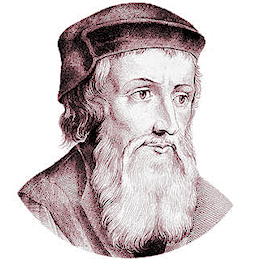Textus Receptus Bibles
John Wycliffe Bible 1382
| 5:1 | Forsothe Aggei, the prophete, and Zacharie, the prophete, the sone of Ado, prophesieden, prophesiynge in the name of God of Israel, to the Jewis that weren in Juda and Jerusalem. |
| 5:2 | Thanne Zorobabel, the sone of Salatiel, and Josue, the sone of Josedech, risiden, and bigunnen to bilde the temple of God in Jerusalem; and with hem rysyden the prophetis of God, helpynge hem. |
| 5:3 | Forsothe in that tyme Tatannai, that was duyk biyende the flood, and Starbusannay, and the counselouris of hem, camen to hem, and seiden thus to hem, Who yaf counsel to you to bilde this hows, and to restore these wallis? |
| 5:4 | To which thing we answeriden to hem, whiche weren the names of men, autours of that bildyng. |
| 5:5 | Forsothe the iye of God of hem was maad on the elde men of Jewis, and thei myyten not forbede the Jewis; and it pleside that the thing schulde be teld to Darius, and thanne thei schulden make satisfaccioun ayens that accusyng. |
| 5:6 | This is the saumpler of the pistle, which Tathannai, duyk of the cuntrey biyende the flood, and Starbursannai, and hise counselouris, Arphasacei, that weren biyende the flood, senten to kyng Darius. |
| 5:7 | The word which thei senten to hym was writun thus; Al pees be to the kyng Darius. |
| 5:8 | Be it knowun to the kyng, that we yeden to the prouince of Judee, to the hows of greet God, which is bildid with stoon vnpolischid, and trees ben set in the wallis, and thilke werk is bildid diligently, and encreessith in the hondis of hem. |
| 5:9 | Therfor we axiden tho elde men, and thus we seiden to hem, Who yaf to you power to bilde this hows, and to restore these wallis? |
| 5:10 | But also we axiden of hem the names `of hem, that we schulden telle to thee; and we han write the names of men, whiche thei ben, that ben princes among hem. |
| 5:11 | Sotheli thei answeriden bi sich word, and seiden, We ben the seruauntis of God of heuene and of erthe; and we bilden the temple that was bildid bifor these many yeeris, and `which temple the greet kyng of Israel `hadde bildid, and maad. |
| 5:12 | But aftir that oure fadris stiryden God of heuene and of erthe to wrathfulnesse, bothe he bitook hem in the hond of Nabugodonosor, Caldey, kyng of Babiloyne; and he distriede this hows, and translatide the puple therof in to Babiloyne. |
| 5:13 | Forsothe in the firste yeer of Cirus, king of Babiloyne, Cirus, the king of Babiloyne, settide forth `a comaundement, that the hows of God schulde be bildid. |
| 5:14 | For whi kyng Cirus brouyte forth `fro the temple of Babiloyne also the goldun and siluerne vessels of Goddis temple, whiche Nabugodonosor hadde take fro the temple, that was in Jerusalem, and hadde bore tho awei in to the temple of Babiloyne; and tho vessels weren youun to Sasabazar bi name, whom `he made also prince. And Cirus seide to hym, Take these vessels, |
| 5:15 | and go, and sette tho in the temple, which is in Jerusalem; and the hows of God be bildid in `his place. |
| 5:16 | Therfor thanne thilke Sasabazar cam, and settide the foundementis of Goddis temple in Jerusalem; and fro that tyme `til to now it is bildid, and is not yit fillid. |
| 5:17 | Now therfor if it `semeth good to the king, rikene he in the biblet of the kyng, which is in Babiloyne, whether it be comaundid of kyng Cyrus, that Goddis hows schulde be bildid in Jerusalem; and sende he to vs the wille of the kyng `on this thing. |

John Wycliffe Bible 1382
The Wycliffe Bible is the only Bible here that was not translated from the Textus Receptus. Its inclusion here is for the Bible's historic value and for comparison in the English language.
John Wycliffe, an Oxford professor produced the first hand-written English language Bible manuscripts in the 1380's. While it is doubtful Wycliffe himself translated the versions that bear his name, he certainly can be considered the driving force behind the project. He strongly believed in having the scriptures available to the people.
Wycliffe, was well-known throughout Europe for his opposition to the teaching of the organized Church, which he believed to be contrary to the Bible. With the help of his followers (called Lollards), Wycliffe produced dozens of English language manuscript copies of the scriptures. They were translated out of the Latin Vulgate, which was the only source text available to Wycliffe. The Pope was so infuriated by his teachings and his translation of the Bible into English, that 44 years after Wycliffe died, he ordered the bones to be dug-up, crushed, and scattered in the river.